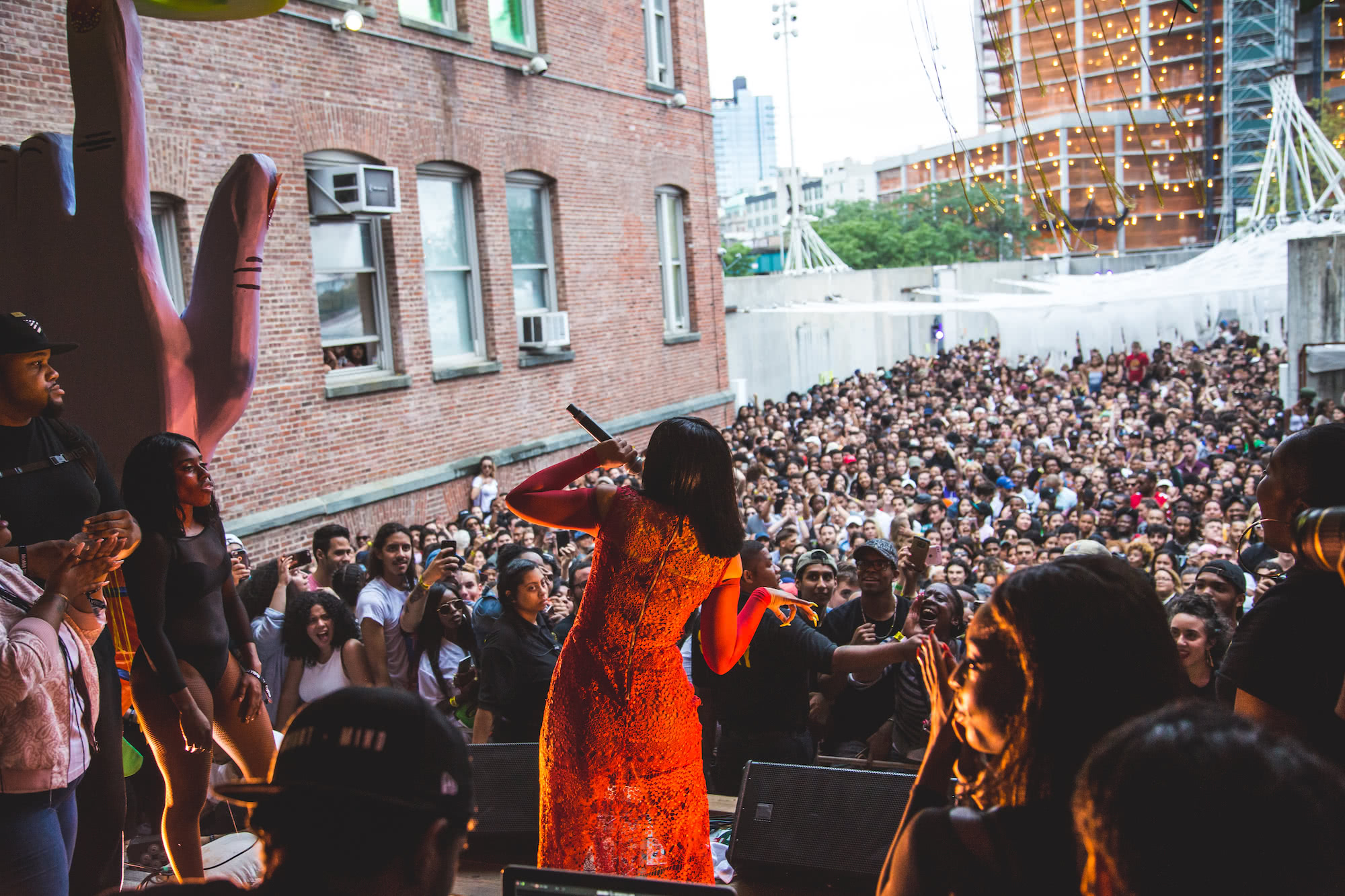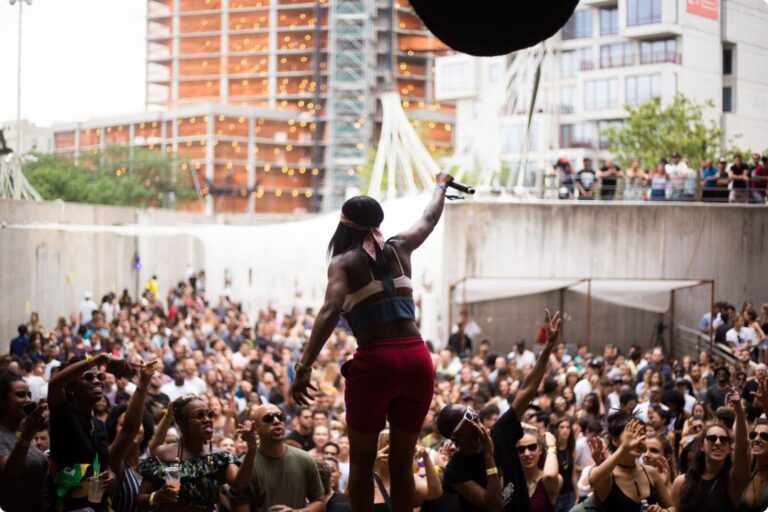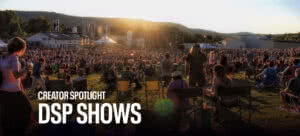Photo of HoodCelebrityy, Warm Up 2017. Photo by: Scott Hoffmann.
Technicolor latex foam seeped out of windows and down ladders leaning against an abandoned building in Long Island City, Queens. Empty, dilapidated auditorium rooms housed metal bookshelves in an ode to a library. Black-and-white photographs adorned classroom walls with chipped paint. Entire stairwells, basements, bathrooms, boiler rooms, and closets were taken over.
In 1976, MoMA PS1 opened the doors to its first major exhibition, Rooms, an invitation for artists to turn any and every space in an abandoned building into site-specific installations. It challenged artists to look beyond the canvas or camera, and gave them the opportunity to transform a 19th century former public schoolhouse into a work of art.

Alanna Heiss and Frederick Fisher, PS1 Reopening, October 26, 1997. © 2019 Lawrence Weiner / Artists Rights Society (ARS), New York Courtesy JOHN BALDESSARI and Marian Goodman Gallery Photo: © Patrick McMullan.
A new kind of art gallery is born
One of the oldest and largest nonprofit contemporary art institutions in the United States, MoMA PS1 was founded in 1971 by Alanna Heiss as part of a project to transform underutilized and abandoned spaces across New York City. During this time, artists and curators were moving beyond the typical museum or gallery setting, showcasing art and performance in public spaces, abandoned warehouses, and piers.
It began as a guerilla museum, without regular hours and without year-round programming. Everything about MoMA PS1 was underground and anti-establishment — giving artists the freedom to express themselves however they wanted. After three years of renovation funded by a city grant that saved the museum from collapse and updated the dilapidated facility, the museum reopened in 1997 as a more conventional museum, with guards, steady hours, and an education department.

Opening of Spring Dance Series (1985): Dance and Popular Culture, May 5–June 23, 1985. Photo: © Anne Turyn.
But today, MoMA PS1’s tradition of long-term installations, artistic exploration and experimentation, and social, cultural, and political discourse still lives on. The converted school has housed exhibitions by greats such as Ansel Adams, Richard Serra, James Turrell, Ai Weiwei, Marina Abramović, and Diane Arbus. As it was 50 years ago when artists first transformed the abandoned schoolhouse, innovation and outside-of-the-box thinking remains the foundation at MoMA PS1. And the museum continues to think beyond the traditional art exhibit.
Performance take precedence at PS1
Since its conception, performance has been at the forefront of MoMA PS1’s curatorial essence. Its first official performance took place under the Brooklyn Bridge in May 1971, five years before it moved into its permanent space in Queens. The Brooklyn Bridge Event brought together all walks of life on the East River in a festival consisting of salvaged material and floating artwork, whole-pig barbecues, and live musical performances. After moving into the abandoned schoolhouse, MoMA PS1 welcomed more regular concert series.
For 24 seasons, Warm Up has been one of the museum’s most successful programs, and it is one of the longest-running music programs housed in a museum. According to Taja Cheek, MoMA PS1’s Associate Curator, Warm Up was conceived in response to the day parties in ’80s Berlin. In an attempt to bring communities and families together outside, MoMA PS1 started hosting Warm Up as a community endeavor to give New Yorkers a place to consistently gather in the summers.
“PS1 is a really unique institution because it comes out of the alternative space movement in New York and is a place where artists use the space in untraditional ways,” says Cheek. “Performance has been a big part of that from the beginning, and even in the early years, there are a lot of examples of PS1 collaborating with other downtown New York music venues and spaces — there’s a lot of cross-pollination there. So nightlife and performance and music have been a really big part of PS1 since the founding. Warm Up is the longest-running program at the museum and it’s a testament to that, but [performance] was happening before Warm Up started in 1998.”

Batya Zamir, Airlines, Batya Zamir: Dance Performance, May 20–21, 1977. Courtesy Batya Zamir. Photo: Richard Van Buren.
MoMA PS1 thwarted traditional expectations of an art gallery and expanded what a gallery could be by collaborating with the city’s hippest clubs. In its early days, roller discos, proms, pool parties, Halloween balls, and punk shows turned museum into nightclub. In 1981, The Mudd Club debuted an art-meets-rock show, New York/New Wave, at the museum featuring works by 118 artists, writers, and punk musicians. In 1982, famed NYC nightclub Danceteria hosted a PS1 party-meets-performance, Serious Fun Night, throughout its four-floor party space. In 1998, the first Warm Up launched, turning the museum’s courtyard into an “urban beach,” complete with a giant inflatable teddy bear, pools, saunas, sunbathing platforms, and a refrigerated room to offer respite from the heat. Music acts DJ Dimitri and Bob Sinclar performed, continuing the tradition of museum-cum-club.
Warm Up brings the heat to Queens for a quarter of a century
Warm Up is rooted in history, welcoming contemporary musicians throughout the decades and giving them a stage on which to celebrate. Solange, Cardi B, Lizzo, Thom Yorke, and A-Trak have all graced the courtyard of MoMa PS1 for the annual summer party. The outdoor event connects local New York and visiting music enthusiasts with important contemporary artists and innovative, underrepresented voices — and they have no plans to slow down anytime soon.

Cardi B performing at Warm Up 2017. Photo: Sara Wass.
Even throughout COVID-19 lockdowns, MoMA PS1 kept the music alive. Of course, capacities were lowered to ensure safety at the museum as well as the courtyard parties, but the events marched on. Now MoMA PS1 has introduced timed entry to the museum, but they have also introduced a hybrid approach to hosting events.
“We offer more,” says Cheek “because like everyone else, we were catapulted into the 21st century when all this happened and had to start doing live streaming.” MoMA PS1 has expanded its audience reach by offering live stream options to their established programs.
It’s no secret that MoMA PS1 is a museum unlike any other. “It’s such a unicorn amongst museums in a way because of the space, because of the unique history, because of the amazing projects we’re able to see through with artists,” reflects Cheek. But despite taking place in a constantly evolving city, MoMA PS1’s programming has been largely left unchanged.

ASAP Ferg performing at Warm Up 2017. Photo: Sara Wass.
“Warm Up has been, at its core, the same since it started, and there’s something really beautiful about that. It’s been in the courtyard. It has a focus on electronic music. It lasts a certain period of time. It happens in the summer. So many of the ingredients are the same.”
But despite the traditions and fundamental ideology that has remained so consistent, Cheek sees a future for MoMA PS1 that may look a little different. “Now that COVID is a thing, it’s really opened our eyes to ways that the program can shift a little bit […] We’re treating the courtyard differently and have way more artist interventions in that space, so we’re finding small but meaningful ways to change the program without completely overhauling it, and that’s super exciting. We just have to stay responsive and see where we’re at next year.”
No matter what the evolution of MoMA PS1 in the coming years, one thing is certain: Warm Up will continue to bring some of the most exciting up-and-coming artists to their courtyard and will continue to amplify underrepresented voices. Performance, innovation, and artistic freedom will always be at the forefront of MoMA PS1’s mission, and we can expect nothing but the unexpected from one of the country’s most unique artistic institutions.
Interested in attending one of MoMA PS1s performances, exhibitions, or shows? Follow them on Eventbrite to be alerted when new events are added.




